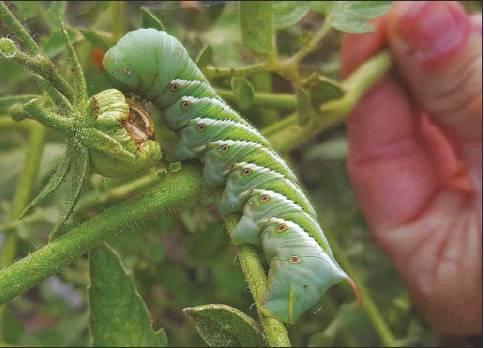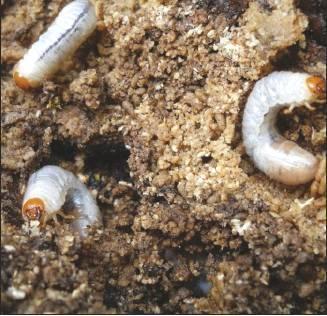What Bugs You
Gardening and yard care can give you satisfying results, such as beautiful landscapes and abundant wildlife. However, yard pests can be discouraging, even for the most committed gardener. It is often enough to make you want to break out harsh chemicals to deal with the problem. But hold on, there are environmentally friendly ways to get rid of these common Texas yard pests too.
The most common insect pests we run into are aphids, caterpillars, fleas, chinch bugs, grubs, mosquitos, spider mites, fire ants, beetles, snails, and slugs. That is a pretty long list but not every pest infests every yard or garden so you will usually only have to deal with a couple. I will talk about a few here today and finish the list in next week’s article.
Aphids are tiny (1/16 to 1/8”) insects with a soft body, long legs, and antennae. Most aphids are host-plant specific and usually do not move to other species. They attack new growth or the underside of leaves. They suck sap from plants and excrete clear, sticky “honeydew” onto leaves. This honeydew often causes a black, sooty fungus that blocks sunlight from leaves. Typically, aphids attack bedding plants, crape myrtle, hibiscus, oaks, oleanders, pecans, vegetables, and roses.
After you identify an infestation, introduce ladybugs, lacewings, and other beneficial insects to your landscape. For best results, follow release instructions carefully and release in an enclosed area. Use sticky barriers to prevent ants from tending the aphids and protecting them from natural predators.
For minor infestations, spray host plants with water at high pressure to dislodge the aphids. Use insecticidal soaps and horticultural oils to help control the aphids. When appropriate, use row covers, which will physically keep the aphids off vegetable crops while still allowing air, light, and water exchange.
Pest caterpillars include the tomato hornworm, the tent caterpillar, the genista caterpillar, and the spring cankerworm. Caterpillars are the larval stage of butter›ies, so butter›y-gardening enthusiasts should expect some caterpillar damage.
Do not treat native trees; caterpillar infestations are natural and rarely threaten the health of a tree unless it is already stressed or weakened. Just monitor infestations of very young caterpillars to see if natural controls such as predators, parasitic wasps, or harsh weather will eliminate the infestation. You can try releasing parasitic wasps when caterpillars first appear.
Dislodge small tent caterpillars with a broom or with high-pressure water sprays, to allow parasitic wasps easier access. Use row covers as a barrier in vegetable gardens. You can treat with Bt (Bacillus thuringiensis) but not near butter›y gardens.
Fleas, tiny insects with hind legs adapted for jumping, can bother both people and pets.
They leave black droppings around pet sleeping areas and jump when disturbed. Flea bites mostly occur on the lower legs and can cause redness and itching.
Most adult ›eas live on the animal host, although ›ea eggs and larvae can be found in moist soil in the yard, as well as in bedding and carpet. The best prevention is to keep your house well-vacuumed, especially where your pet rests. Be sure to immediately dispose of vacuum bags after use, to prevent ›eas from escaping back into your home.
You can also steam clean carpets to remove organic material, which is food for ›ea larvae and wash your pet’s bedding regularly in hot water. If pets sleep with you, wash your bedding frequently as well. Shampoo your pet regularly with a gentle shampoo to remove ›eas and ›ea eggs. Shampoos containing pesticides are not necessary, because any soapy water will kill ›eas.
If areas of your yard are heavily infested with ›eas, treat these areas using a spray of beneficial nematodes. These organisms kill ›ea larvae but are not harmful to the environment.
Chinch bugs are small and slender (1/6 to 1/5” long). They have black bodies and whitish wings with black “bases” on their forewings. Recently hatched nymphs are wingless and pinkish-red, with a light-colored band across their backs.
Chinch bugs primarily attack St. Augustine grass, but may feed on zoysia or Bermuda grass as well. They cause expanding, irregular patches of dead or stunted grass surrounded by a halo of yellowing, dying grass.
Make your yard a haven for beneficial predator insects, big-eyed bugs, and birds, by avoiding the wide use of lawn chemicals. Check for chinch bug infestation on the grass blades at the edges of affected areas. To test, cut the bottom out of a coffee can, push the can one inch into your turf near the edge of a dead patch, and fill the can with water. If chinch bugs are present, they will ›oat to the surface where you can spot treat only the infected areas, with insecticidal soaps.
Grubs are small (1/2 to 1” long), C-shaped, and creamy white, with three pairs of legs. Grubs are the larva stage of the June beetle, or June bug. Grubs attack St. Augustine, Bermuda, zoysia, and buffalo grasses. They feed on roots and other underground parts and are most prevalent during the summer and fall months.
Your least toxic solution for grubs is to only treat when more than 5–10 grubs per square foot are found. When this is the case, apply beneficial nematodes to the affected areas. Choose the most effective time for treatment: mid-June to late July.
Spider mite adults are tiny (1/150 to 1/50”), spiderlike insects with eight legs and no antennae. They vary in color. They lay their eggs on the underside of leaves and on buds. They attack fruit trees, tomatoes, marigolds, strawberries, roses, junipers, rosemary, and many house plants.
To determine if you have spider mites, take a white piece of paper and strike some affected leaves on it, you’ll see the mites crawling on the paper. Your course of action is to encourage natural enemies like green lacewing larvae, ladybugs, and predatory mites.
For minor infestations, spray the host plants weekly with high-pressure water, spraying upward from beneath of the plant foliage.
We all know it is important to protect our environment, but many of us will still turn to pesticides to try to solve our problems. I get it, but if you feel that you must use a pesticide, make choices that are less harmful to the environment:
• Use the least-toxic pesticide first. always read the label and follow the instructions of any pesticide you choose.
• Avoid applying broad-spectrum pesticides; they destroy beneficial insects as well as pests, leaving trees or shrubs even more unprotected if pests return.
• Apply pesticides only to plants that are specified on the label. Some formulations injure tender ornamental plants and new growth.
• Mix pesticides according to their directions and apply only the recommended dosage. More is not better!
• Avoid systemic pesticides on vegetables and other edible plants. Systemic pesticides are taken up by the plant, making its tissues and ›uids toxic to feeding pests, and often, unsafe for human consumption too.
• Apply non-systemic pesticides to all infested plant surfaces. Non-systemic pesticides must come into direct contact with the insects in order to work.
• Avoid the overuse of chemicals. Many pests have become resistant to certain pesticides.
In most cases, disposing of leftover or unwanted pesticides in the regular trash is acceptable. However, there are disposal options that better protect the environment. Consider taking these kinds of items to a household hazardous waste facility for disposal. You can visit www.recycletexasonline.org or www.cleanup.org to find a location




